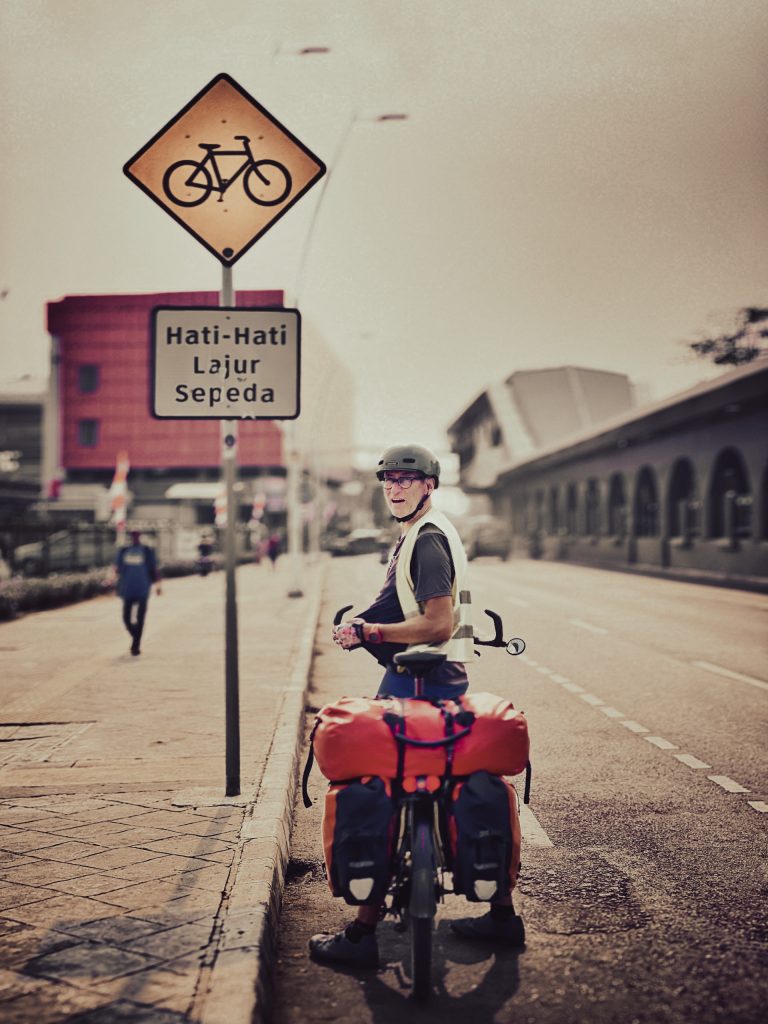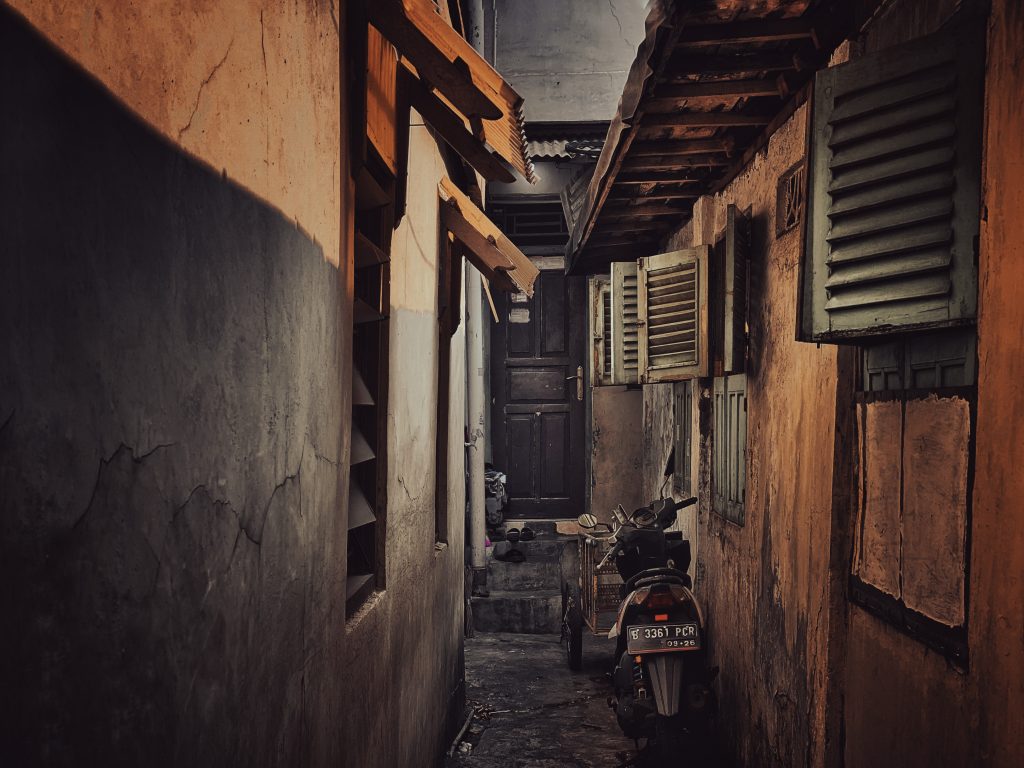Jakarta Keras = Jakarta is hard and loud
The capital of Indonesia, and of course the capital of the island of Java, is a megacity of contrasts. The metropolitan region is home to more than 30 million people. On one corner real poverty, on the next chic shopping malls, hotels and skyscrapers. The city’s official nickname is “The Big Durian,” prickly and stinky with a surprisingly soft, sweet core. I’m not sure I agree with that. Durian is also a real stinky fruit. But that’s definitely in the eye of the beholder.

I don’t want to visit mosques, cathedrals, museums or galleries anymore. And also shopping malls, colorful markets, Chinese quarters or old towns are no longer what we are looking for. What kind of juggernaut would we end up in this time?
I am emotionally at the end. The last months and weeks have been so draining. It’s not just about the physical exertion, especially the mental.
0.0 I have the feeling of wanting to explore the city. I would love to hide in my hotel room and stay until we leave again. And for a little bit, that’s what it was like. We prepared the bikes for the stages Java to Bali. Got our laundry in order at a coin-operated laundromat. We slept a lot.
Some facts about Jakarta
More than 8 million people are said to live in the city. We can confirm that it is crowded. Therefore we decide not take the bicycles and we explore a few corners by foot. Somehow nothing new. High-rise buildings and old parts of the city. A little slum, but quite okay. Sewage, electricity and garbage works in many places, of course not everywhere. We eat at the street stalls or buy a few things like salad and fruit, which we then eat back in the room, secluded from noise and dirt.
Then we still get out our bikes and explore the old Dutch settlements, unfortunately rather run down and visit a few neighborhoods, eg the Chinese. It is too crowded and we escape to a small quiet coffee, with air conditioning, croissants and cheese cake 🙂

A short report, a short stay.
Bicycle paths in Jakarta?
However, something really surprised and pleased us. There is a large network of bicycle paths. Not least certainly due to the efforts of a local cycling group. Over 50% of air pollution is due to public transportation. Something needs to be done.


And the fight for bike lanes is certainly not an easy one in this city
I know the arguments against the bike lanes in Berlin and I wish there would be a rethinking faster. Because until last, on my 15 km in the morning and evening to work I was violently harassed by car exhaust fumes, noise and any unfounded tantrums of motorists up to endangerment. There we are not very progressive in our city.
But now back to Jakarta and the bike lanes: Bicycles, the future mode of transportation for traffic congested Jakarta.
Jakarta has joined ITDP’s Cycling Cities campaign, which brings together cities, non-governmental organizations and other partners to make cycling a safe and affordable transport option worldwide. There is a need to ensure that more people choose to cycle.
Global demand for cycling has exploded in 2019, with many calling it the future of urban transport. Cycling is cheap, versatile and the CO2 free mode of transport. Without cars clogging the streets, people can reclaim space. In many parts of Jakarta, the number of cyclists has increased significantly since partial closures were enforced.
B2W Bike to work Indonesia
ITDP Indonesia, along with local partners such as Bike2Work Indonesia (B2W) , has worked closely with the city of Jakarta to design a 500 km network of bike lanes. Some initiatives focus on groups that may not have much access to cycling: such as students or women.
I heard about B2W through our new friend from Batam. Indonesians are really a bike-crazy people. There are groups and even more groups that meet permanently for common events. A huge community. That might explain a little bit of the pressure they can put on the government.
In response to the COVID-19 pandemic, numerous protected bike lanes were established. Many of the lanes brought bicyclists onto the streets where they had not been before. In some cases, the number of bicyclists increased by 1000% compared to before the pandemic. An online survey and an on-site survey conducted after the introduction of the bike lanes suggest that many people would be willing to commute by bike, even for longer distances, up to 11 km, if the bike infrastructure were properly developed. In early 2021, the provincial government committed to making the pop-up lanes permanent protected bike lanes. This decision was met with enthusiasm from citizens and policymakers alike. A survey of pop-up lane cyclists conducted by ITDP Indonesia found that a protected or separated bike lane was the most desired amenity, and that in this context, unkempt roads, aggressive drivers, and high speeds were the biggest concerns.
Sound familiar? Don’t we know it all from our big cities in Germany?
And then again these blockers. Here in Indonesia, too. What are they afraid of? That they are no longer wanted on the streets in their fat box? That their toys will be taken away from them? Or that they will have to move around the city without air conditioning? Or that they will have to use public transport? Loss of status? In early 2021, enthusiasm for the protected bike lane was challenged by a statement that indicated the protected bike lane would be demolished in an attempt to rescind the rights of the many cyclists, with the police agreeing.
Portions of the bike lanes were closed and police prohibited bicyclists from riding in the protected bike lanes. Police claimed that recreational cyclists would lead to overcrowding. However, a survey conducted by ITDP Indonesia found that the road is used by cyclists with a wide variety of needs, including vulnerable groups. The bike lane again demonstrated the need for safe and convenient bike lanes for people with different abilities and needs.

I certainly didn’t think of bike lanes when I thought of Jakarta, and I’m glad that it’s such a big issue in such a big city. However, with all the networking in the world, I do wonder and it also makes me a little sad that we don’t all work together more globally and share the results worldwide. That would certainly help get to better traffic routes for cyclists faster. It seems that everything has already been said and yet we have to discuss the sense and nonsense of protected bike lanes again and waste time.









